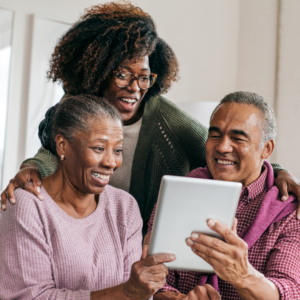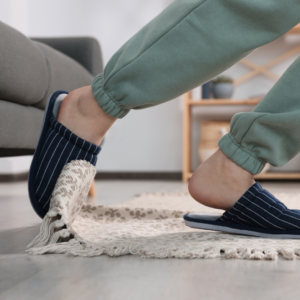Fall prevention for seniors



Falling is one of the main concerns for Seniors. A trip or stumble when at a younger age may have very little consequence. But as you age, that same trip or stumble can trigger a cascade of complications that have the potential of being debilitating. It is so important to create a safe environment to prevent falls. And, there’s more to it than just rugs and flooring.
Lighting Considerations Have you noticed that rooms seem dimmer and reading is more difficult because it seems you can’t get enough light on the subject? Besides waning eyesight, less light reaches our retinas as we age. This causes us to need more light in our environment so that we can see not only what we are reading, but also where we are stepping and walking so that we can avoid falls and other accidents.
The best way to light your environment it to use motion sensor lighting as much as possible. Some new beds include this under the bedframe so that you can see in the dark when you get up at night. Motion sensor lights can also be installed in closets, hallways, and bathrooms. Motion senor lights could also be installed on stairways close to the steps for better visibility. Painting stairs so that the top and bottom steps have a lighter color on them makes them easier to see. A handrail is essential on steps whether they are steep or not.
Doors & Door Knobs French door handles or lever handles are much easier for Seniors to operate than round doorknobs. Round doorknobs can be difficult to grip with arthritis or weak hands. The lever handles are much easier to operate and more convenient. If possible, install sliding and pocket doors rather than barn or swinging doors. Swing doors consume a lot of floor space to be operational. Barn doors take less space than swinging doors, but you still must consider the wall that the door will hang on when open and you may not be able to place any furniture in front of it.
lace rugs with nonskid mats on polished floor surfaces, and invest in anti-slip tiles for bathrooms and kitchens. If you get carpet, it should be flat and dense, not fluffy, which can lead to tripping.
Floors Floors are usually the first things that are considered when evaluating a house for fall hazards. It’s best to use flat and dense carpet that a wheelchair or walker can easily be moved on. Thick carpet pads, carpets, and fluffy or shag carpets are difficult to maneuver on and cause tripping hazards. Rugs are best avoided as the corners and edges can be trip hazards. However, if a rug is used, it also should be as flat and dense as possible with nonskid backing. For hard surface flooring, anti-slip tiles are a good investment. The transitions used from one surface to another should also be carefully considered. They should be as flat as possible so that they do not cause tripping or difficulty in getting over them.
Technology and Communications. Technology is not always considered when thinking about falling. However, cords and connections can be hazards to overcome. In addition to making sure the technology in the home is up to date, it is important to have ease of access to the outlets. Power strips set within easy reach instead of on the floor behind furniture so that the Senior does not have to struggle to reach their chargers or cords is essential.
Seniors need to be able to communicate easily. Make sure that High-speed Internet service, working smartphones or tablets, and access to social media or messaging services is available. A Fitbit or a voice assistant that uses a smart speaker, such as Alexa, can be used to help with medication reminders, grocery lists and tracking the weather. And, for added security, the Ring video doorbell system allows you to monitor who is at your door. It’s important to choose technology that is simple to use and easy for a Senior to navigate so that the effectiveness of the device can be beneficial.
Another part of communication for Seniors is to be able to send and receive messages, photos, videos and live chats. Finding easy to use, secure apps that facilitate these communications easily is a great way to help Seniors not feel isolated from their loved ones. It is easier now more than ever to stay in touch.
Bathroom. Handrails or grab bars by the toilet and by shower controls help with stability. It is helpful to have a bidet toilet with a night light. Not only do they conserve toilet paper, they are gentle on the skin, more sanitary than toilet paper, and make it easier for Seniors who suffer from arthritis or shoulder pain or other injuries that make reaching around difficult.
For the tub and shower, it is important to have easy access. Avoid having any steps into the shower. Make sure there is a seat in the shower. Many Assisted Living Communities have built in shower seats. Install a shower head that has a hand sprayer. If you have a tub, make sure there are plenty of grab bars placed in the correct position to assist getting into and out of the tub. The tubs with the side-panel doors are an excellent choice.
Kitchen. There’s no need to struggle with heavy pots and pans such as cast-iron skillets. Remove them from the kitchen and use lighter pots and pans. The same goes for any heavy plates, dishes, coffee mugs, glasses, and serving dishes. There is more of a chance of falling when struggling to carry something too heavy. Try to place the most used items within easy reach. Get rid of the step ladder! Place the microwave at eye-level. An automatic shut-off for the stove can be installed to prevent a fire. Air Fryers should remain unplugged at all times when not in use.
Living room. Power chairs and lift chairs that are wall huggers are excellent choices for the living room. If moving into Assisted Living, keep in mind the space will be smaller and choosing a wall hugger chair will give more space to maneuver around the living room. This is important because many times Seniors want to take their oversized easy chair and a coffee table and end tables and a sofa. It is nearly impossible to fit all of those large pieces of furniture into the living room and still have enough room to maneuver around without bumping into corners of furniture and bruising. Be realistic about enough space to use a walker to navigate your living room. Choose furniture that has multiple uses if possible: coffee tables that the top lifts for a desk or tray. End tables and chairs that have chargers built in. Avoid glass tables or furniture with sharp corners. These often cause falls and bruises.
Bedroom. The ideal bed height is 21 inches from the floor. This is the same height as a chair. Footboards are easily bumped into or catch toes and cause falls while walking around the bed. If you use a bench or chair in the bedroom, choose one that has side arms so you can get up easily. Nightstands should be able to accommodate glasses, medicines and a drink. If you have a CPAP machine, it needs to accommodate that as well. The nightstand should not be so large that it impedes getting into or out of bed. There should be light next to your bed. Some bed frames or adjustable bases include motion sensor lighting which is also very helpful.
Follow these basic guidelines and you will be well on your way to preventing falls due to the furnishings in your home.
